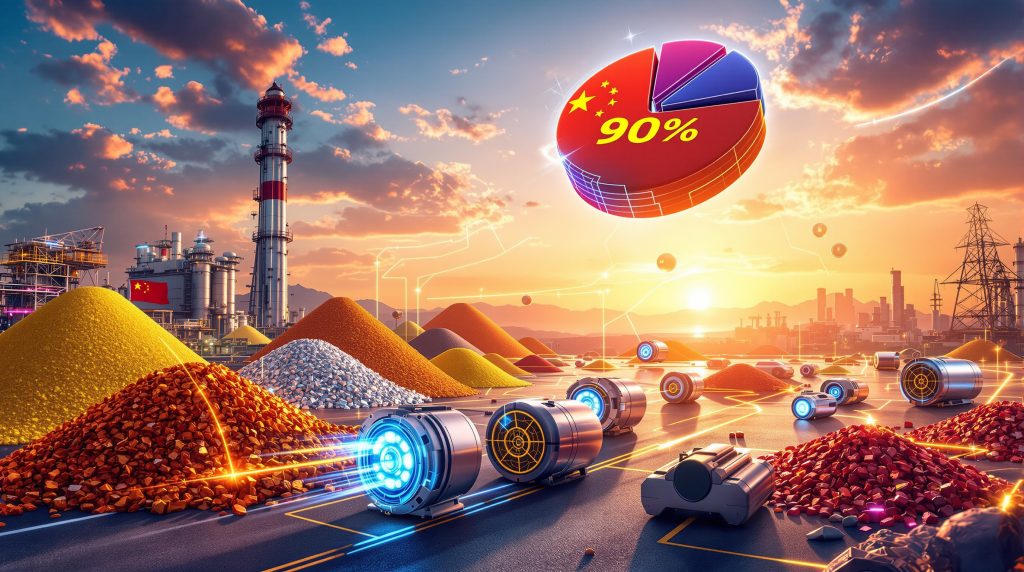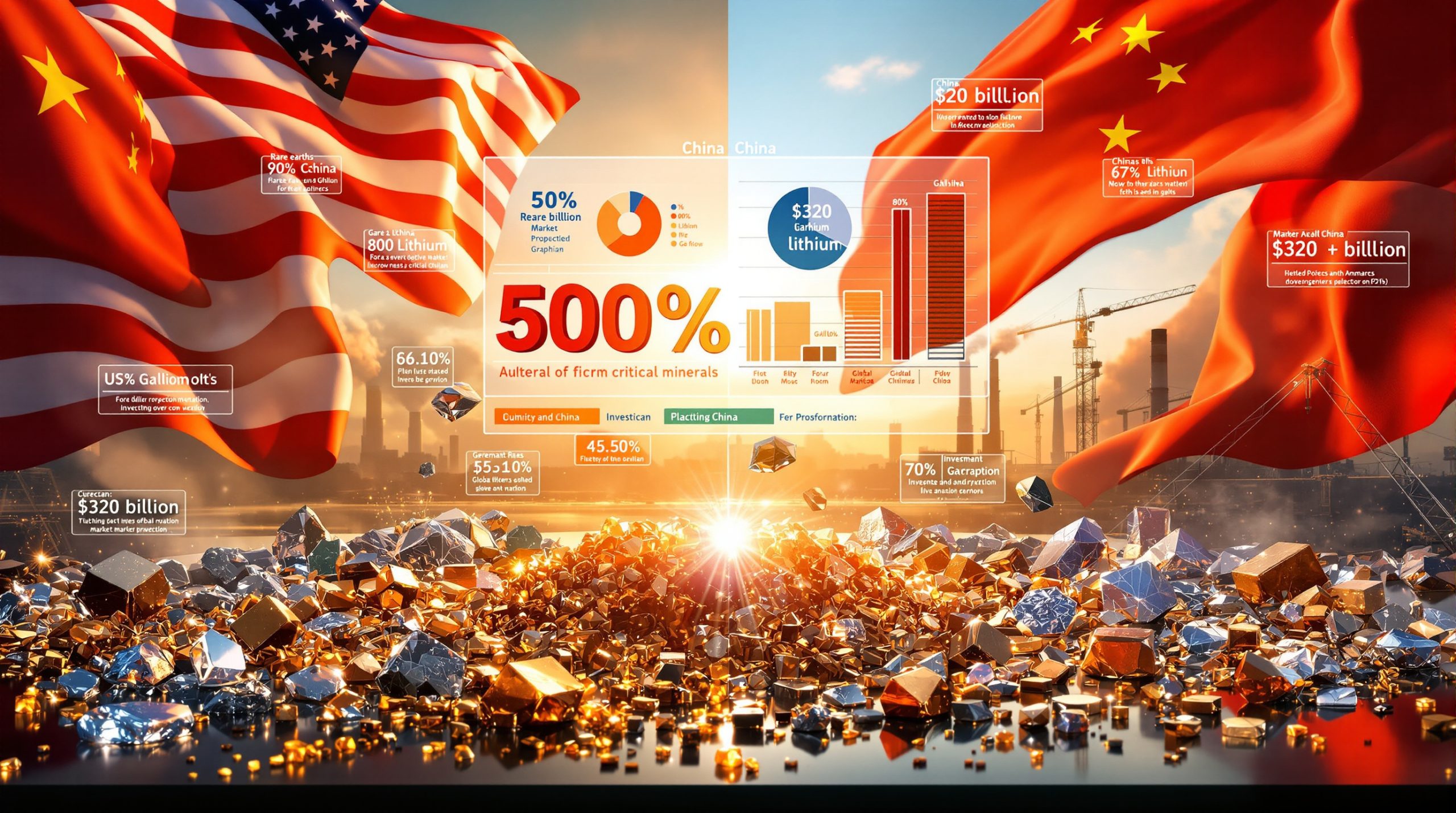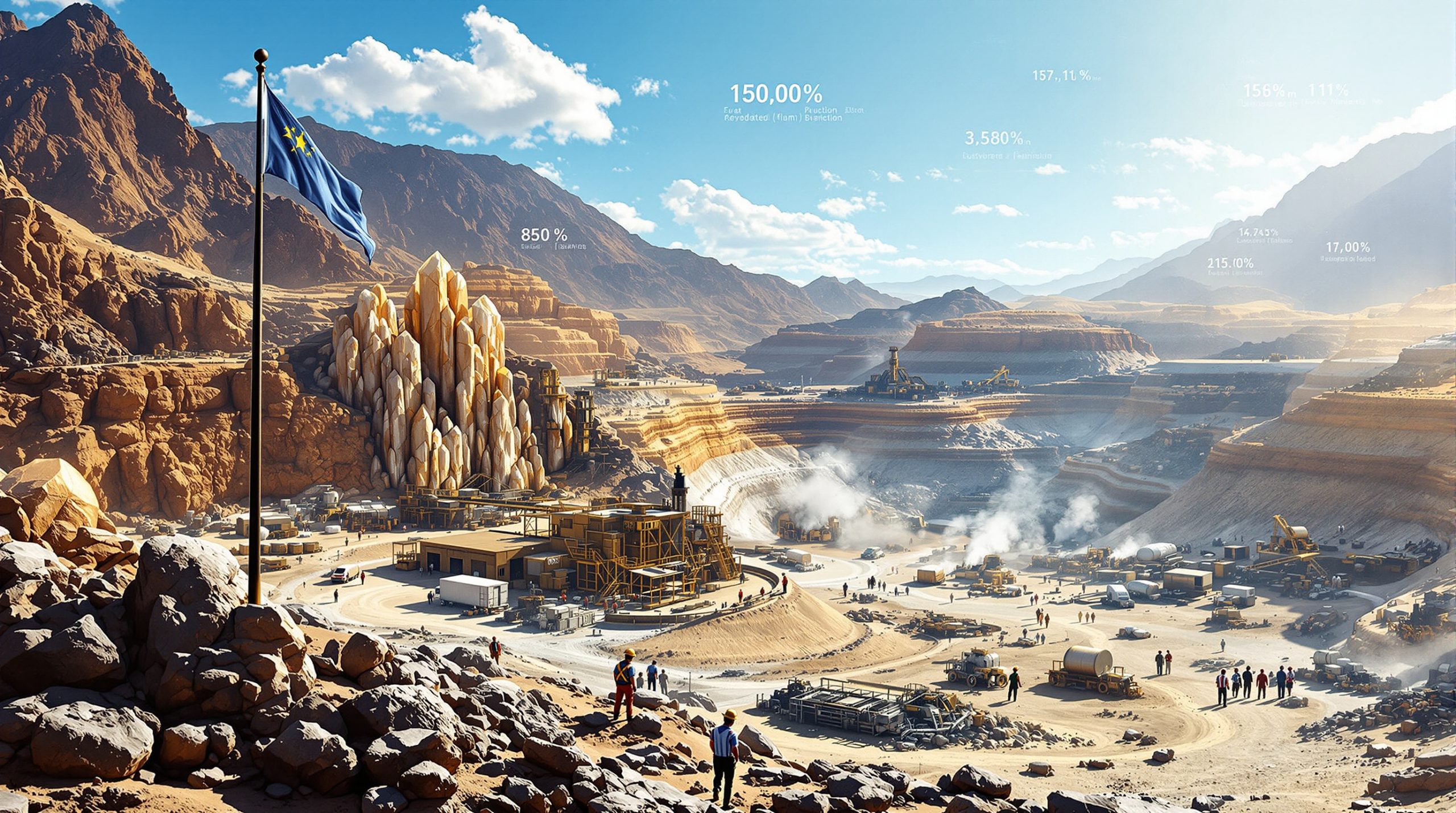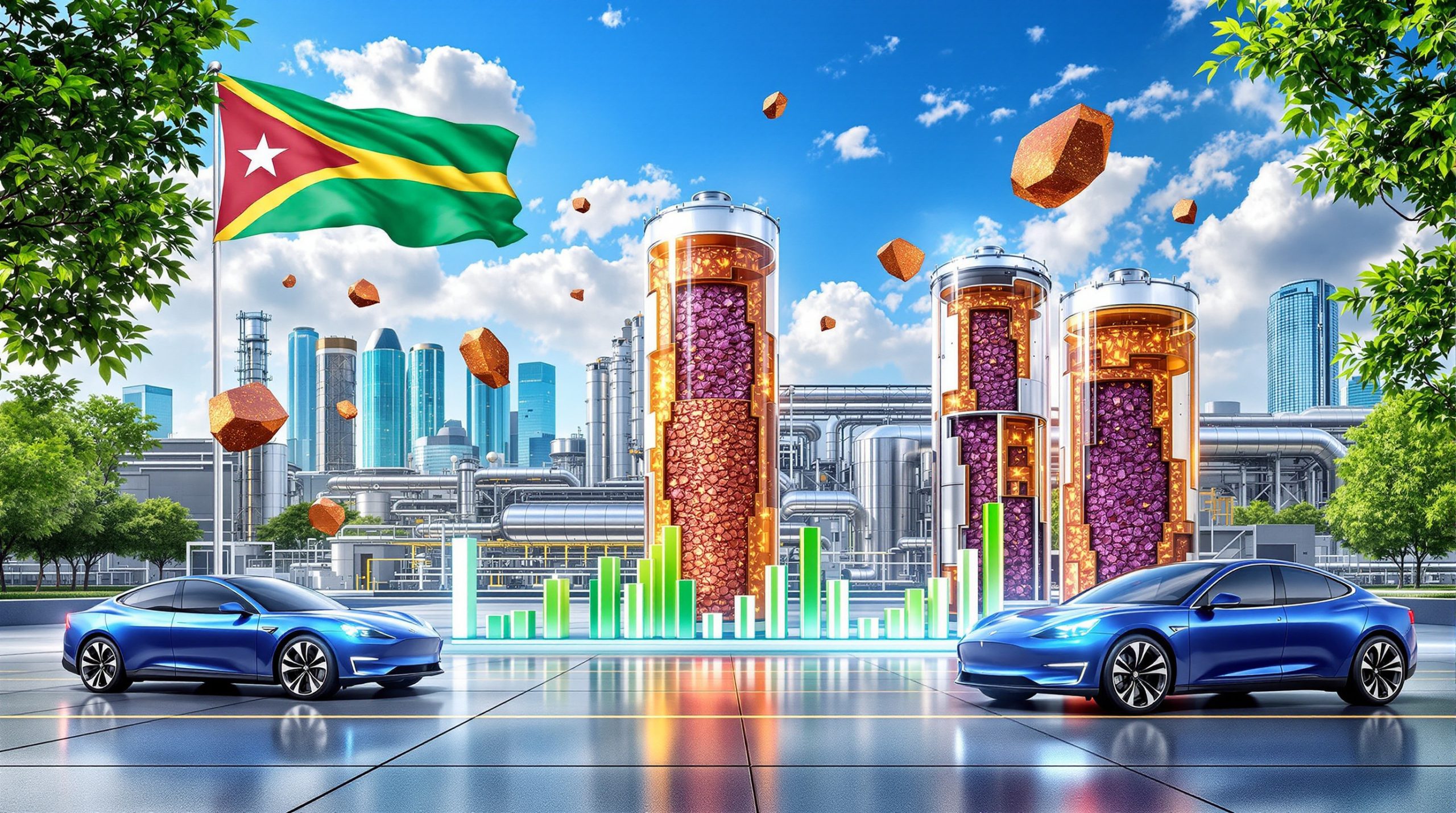China's stranglehold on global rare earth production creates unprecedented vulnerability for concerned carmakers racing to beat China's rare earths deadline. The nation maintains control over approximately 70% of worldwide mining operations, 85% of refining capacity, and an overwhelming 90% of rare earth magnet manufacturing, according to consultancy AlixPartners estimates. This concentration becomes particularly concerning as new export regulations took effect November 8, 2025, extending far beyond traditional trade restrictions.
The critical minerals energy transition faces unprecedented challenges as supply chain vulnerabilities emerge. For heavy rare earths specifically, China's dominance reaches near-monopoly levels, controlling 99.8% of global refining capacity. This statistical stranglehold makes alternative sources practically negligible for automotive manufacturers seeking to diversify their supply chains.
Understanding the Scope of China's Expanded Export Restrictions
Key Elements Under New Export Controls
The expanded restrictions target critical rare earth elements essential for automotive manufacturing, with the new Chinese export control list including:
• Ytterbium for advanced sensor systems
• Holmium for magnetic components
• Europium for display technologies
• Heavy rare earth elements where Chinese refining control approaches totality
The announcement came on October 9, 2025, giving automotive manufacturers less than one month to prepare for the November 8 implementation date. This compressed timeline created significant pressure for procurement teams already managing depleted inventories from earlier supply disruptions. Furthermore, Reuters reports that industry executives are scrambling to secure alternative suppliers before the restrictions take full effect.
How Are Automotive Companies Responding to Supply Chain Pressures?
Immediate Stockpiling Strategies
Industry executives report aggressive inventory building ahead of the November deadline, though many companies face challenging realities. Nadine Rajner, CEO of German metal-powder supplier NMD, characterised the current situation as very tense, noting that customers actively seek to source rare earths from any location excluding China. Her company reports being practically sold out with limited stock availability.
Current Supply Chain Challenges:
• 45-day shipping times from China to European markets
• Depleted inventory levels from previous restrictions
• Limited export licence availability from Chinese suppliers
• Rush orders creating bottlenecks in processing
Bruno Gahery, president for France, Benelux, West and South Europe at supplier Bosch, anticipated that the automotive industry would engage in overstocking rare earths as a defensive strategy before the implementation deadline. However, an executive at a magnet supplier for Hyundai revealed that while inventory building occurred earlier in 2025, most supplies had already been depleted, leaving current stocks tight.
Three industry sources confirmed that some Chinese rare earths exporters experienced a surge of orders from overseas clients immediately following the October 9 announcement. This highlights the immediate impact of the export control news on global procurement patterns for concerned carmakers racing to beat China's rare earths deadline.
Geographic Diversification Efforts
Automotive manufacturers actively pursue alternative sourcing strategies, though options remain severely constrained. In addition, Australia's critical minerals reserve initiatives represent key opportunities for supply chain diversification. While rare earth deposits exist globally, the infrastructure for extraction and processing remains underdeveloped outside China.
The US-Australia critical minerals agreement signed October 21, 2025, by President Donald Trump and Australian Prime Minister Anthony Albanese represents initial steps toward supply chain diversification. However, this follows the critical minerals executive order that establishes policy frameworks for reducing dependency on Chinese supplies.
Government Response Timeline:
• Agreement signed: October 21, 2025
• Investment pipeline value: $8.5 billion according to Prime Minister Albanese
• Focus: US investments in Australian rare earth mining projects
However, Rajner noted that while countries like Sweden possess abundant rare earth availability, they lack the necessary mines and refining capacity to make these materials industrially usable. This infrastructure gap represents a fundamental challenge for diversification efforts.
Which Automotive Components Face the Greatest Risk?
Electric Vehicle Motor Systems
Rare earth magnets serve as the backbone for numerous automotive components, creating cascading risks throughout vehicle production. These materials prove essential for powering systems across both traditional and electric vehicles, though they assume even more critical roles in EVs according to industry sources.
Traditional Vehicle Applications
Conventional automotive manufacturing relies heavily on rare earth elements for numerous everyday components:
• Side mirror adjustment motors requiring precise magnetic control
• Audio system speakers dependent on rare earth magnet performance
• Oil pump mechanisms utilising magnetic drive systems
• Windshield wiper systems incorporating rare earth-powered motors
• Fuel leak detection sensors relying on rare earth element sensitivity
• Braking sensors requiring rare earth magnetic properties
The pervasive nature of these applications demonstrates how supply disruptions could affect virtually every aspect of automotive manufacturing. Consequently, disruptions range from basic comfort features to critical safety systems.
What Alternative Technologies Are Automakers Developing?
Rare Earth-Free Motor Innovation
Leading manufacturers accelerate development of alternative motor technologies to reduce dependency on Chinese-controlled materials. Companies including General Motors, ZF, and BorgWarner pioneer low-to-zero rare earth content motors, while BMW and Renault have successfully produced completely rare earth-free alternatives.
Dominic Vergine, CEO of UK firm Monumo, reports achieving an impressive 24% average reduction in rare earth content for motors already in production through AI and deep-tech simulation methods. His company serves several of the world's top 10 carmakers, demonstrating the widespread industry interest in rare earth reduction technologies.
Technology Development Status:
• Current prototypes showing significant rare earth reduction
• Next-generation motors targeting complete elimination
• Commercial deployment timeline extending years into the future
• Most advanced motors remaining years away from widespread adoption
Recycling Infrastructure Development
The automotive industry explores rare earth recovery from end-of-life vehicles as a sustainable alternative. Neutral, a Renault-backed company, currently processes rare earths from 400,000 vehicles annually in France, maintaining contracts with 15 European automotive brands.
However, Jean-Philippe Bahuaud, CEO of Neutral, identified scaling these activities as the primary challenge. He noted current operations cannot meet industry-wide demand, which becomes increasingly relevant as concerned carmakers race to beat China's rare earths deadline.
How Might China's Export Controls Affect Vehicle Production?
Manufacturing Disruption Scenarios
Industry analysts warn that China's rare earth controls could trigger widespread production disruptions within weeks of implementation. The US‑China trade war impact demonstrates how quickly geopolitical tensions can disrupt global supply chains.
Ryan Grimm, Toyota Motor's North America group vice president of purchasing supplier development, stated that China's control over rare earths supply could enable them to shut down the entire automotive industry within two months. This highlights the severe vulnerability of automotive manufacturing to supply disruptions.
The automotive sector's just-in-time manufacturing model leaves minimal room for extended supply interruptions. Consequently, this could potentially force temporary plant closures across multiple regions. With 45-day shipping times from China to Europe, orders placed after late September 2025 would not arrive before the November 8 restrictions took effect.
Regional Impact Variations
Different global markets face varying exposure levels to these supply chain risks, though comprehensive regional risk assessments require ongoing monitoring as the situation develops. For instance, the India‑Australia lithium strategy showcases alternative partnership models for critical mineral security.
The compressed timeline between announcement and implementation created particular challenges for European manufacturers given the extended shipping distances involved.
What Long-Term Market Changes Are Expected?
Investment in Alternative Supply Chains
The rare earth supply crisis drives unprecedented investment in non-Chinese production capacity. However, these projects face significant challenges from potential Chinese price competition. Andy Leyland, co-founder of supply chain specialist SC Insights, noted that Beijing historically focuses on competing through price advantages and will likely continue this strategy.
Leyland emphasised that Chinese producers can always undercut alternative suppliers, making investments in rare earth-free motors or alternative supply sources particularly risky. When faced with cheaper motors containing rare earth magnets, automakers may find it difficult to justify more expensive rare earth-free components.
Technological Innovation Acceleration
Supply chain pressures catalyse rapid advancement in rare earth-free technologies. While these innovations show promise, the transition timeline extends beyond immediate supply crisis resolution. This creates a gap period of heightened vulnerability for automotive manufacturers as concerned carmakers race to beat China's rare earths deadline.
Jan Giese, senior manager at rare earth trader Tradium, suggested that export controls represent an ongoing strategic approach rather than temporary measures. He stated that additional restrictions should be expected in the future. This perspective indicates China will continue exerting power over rare earth supplies through successive control implementations.
Furthermore, rare earths mining is experiencing significant growth as investors recognise the strategic importance of these materials for technological advancement.
How Are Governments Responding to Supply Chain Vulnerabilities?
Strategic Policy Initiatives
Government responses demonstrate varying approaches between regions, with experts noting that the US government takes the threat far more seriously than European counterparts. The US-Australia critical minerals agreement finalised October 21, 2025, represents concrete action toward supply chain diversification. However, implementation requires years to reach meaningful production levels.
Agreement Key Points:
• Signatories: President Donald Trump and Australian Prime Minister Anthony Albanese
• Focus: US investments in Australian rare earth mining projects
• Value: $8.5 billion investment pipeline according to Australian leadership
• Timeline: Long-term development requiring years for meaningful impact
Industry Support Mechanisms
Policy makers develop support frameworks for alternative supply chain development, though current initiatives remain in early stages. The challenge involves balancing immediate supply security concerns with long-term strategic independence from Chinese rare earth dominance.
Infrastructure development outside China faces the persistent threat of being undermined by Chinese price competition. Beijing can maintain artificially low prices to discourage alternative supplier development. This dynamic creates ongoing uncertainty for investors considering non-Chinese rare earth projects.
What Should Investors and Industry Stakeholders Monitor?
Key Performance Indicators
Stakeholders should track several critical metrics to assess ongoing supply chain risks:
• Chinese export licence approval rates for rare earth shipments
• Alternative supplier capacity development timelines and progress
• Rare earth-free technology deployment across automotive manufacturers
• Regional inventory levels and pricing trend analysis
• Government policy responses and bilateral agreement implementations
Market Opportunity Assessment
The supply chain crisis creates both risks and opportunities across the automotive ecosystem. Companies successfully developing alternative technologies or securing non-Chinese supply sources may gain significant competitive advantages. Meanwhile, those remaining dependent on Chinese materials face heightened operational risks.
Investment Considerations:
• Technology firms developing rare earth alternatives show promise
• Alternative mining projects face Chinese price competition risks
• Recycling infrastructure represents emerging opportunity
• Supply chain diversification creates new market dynamics
The situation requires careful monitoring as concerned carmakers continue racing to beat China's rare earths deadline while simultaneously developing longer-term supply security strategies. The compressed timeline between announcement and implementation demonstrates how quickly supply chain vulnerabilities can translate into operational challenges across the global automotive industry.
"The automotive industry faces an unprecedented challenge in securing rare earth supplies, with implications extending far beyond vehicle production timelines," noted industry analysts tracking the developing situation.
Disclaimer: This analysis involves speculation about future market conditions and regulatory developments. Supply chain dynamics, government policies, and technological development timelines remain subject to change. Investment decisions should consider multiple factors beyond rare earth supply considerations.
Ready to Capitalise on Critical Mineral Supply Chain Disruptions?
Discovery Alert's proprietary Discovery IQ model provides instant notifications on significant ASX mineral discoveries, including rare earth and critical mineral breakthroughs that could reshape global supply chains. Explore how historic mineral discoveries have generated exceptional returns whilst positioning yourself ahead of the market with Discovery Alert's 30-day free trial today.




